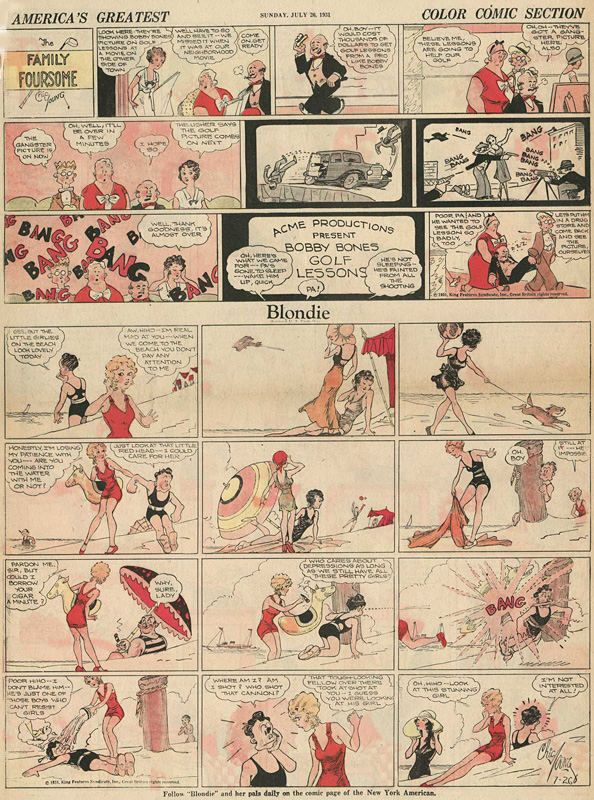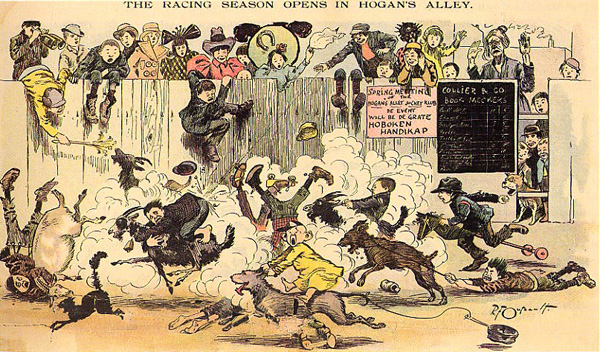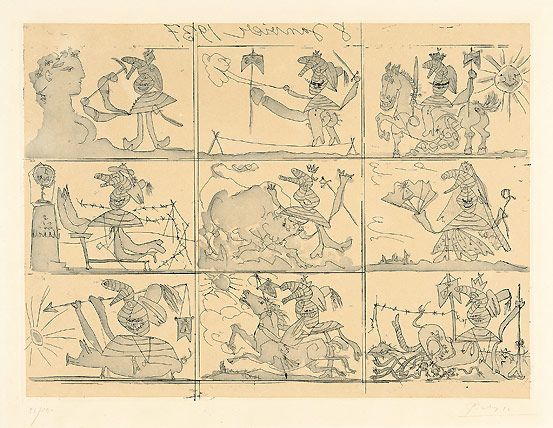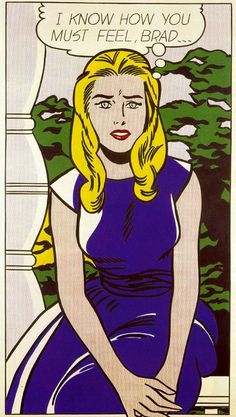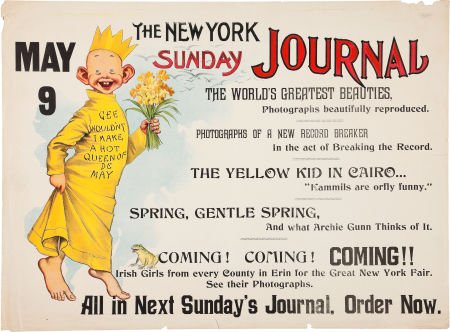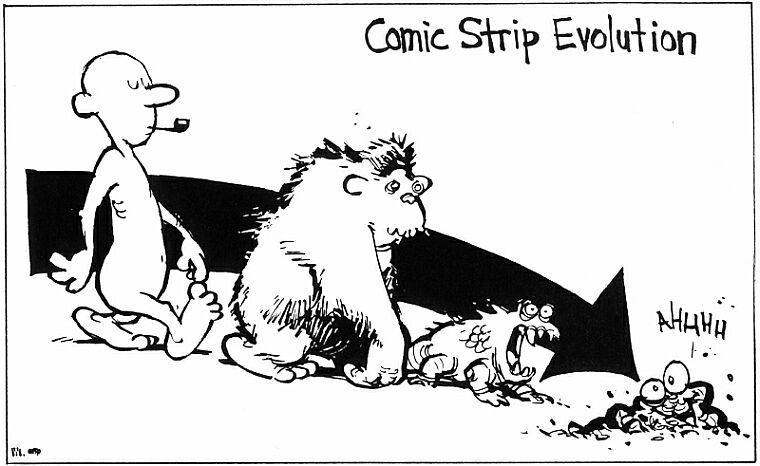"OOF!" The Comics are Shrinking by Mike Talley
|
Comic strips are treated poorly in the medium where they thrive. Looking back at old newspapers, I see an incredible shrinking trend in comic strip size. Reading through old comic collections, I see where cartoonists have cried for help and attention using the characters in their own strips! Locally, the Richmond Times-Dispatch has recently reduced the number of pages in its Sunday comics section. In effect, cartoonists are forced to draw simple, static, easy-to-see characters in tiny panels. Lettering must be large and brief for the comic to be legible. Lavish comics like "Calvin and Hobbes" have disappeared because there is no longer space to create beautiful landscapes and adventures! So why are comics shrinking? Newspaper editors, educators, intellectuals, and the majority of readers, who have the power to speak out against reduction, often overlook the comic strip as an important part of history, art, and culture. Comics have made a remarkable contribution to society, yet they are generally dismissed as unsophisticated, entertaining daily punch lines whose characters are waiting to be merchandised. This paper will explore the gradual size reductions in newspaper comics; these reductions symbolize the little appreciation given to the comic strip as a unique medium with historical, artistic, and cultural significance.
Comic strips are historically significant because they were extremely influential in attracting readers and selling newspapers at the moment of their inception. Joseph Pulitzer and William Randolph Hearst engaged in a bitter struggle to lure each other's readers, both using Richard Outcault's "Hogan's Alley" comic strip. The widespread popularity of the comic strip could make or break a newspaper, depending on what comics were featured. The attractive power of the comics continues to exist; whenever a newspaper drops or replaces a comic strip, countless letters immediately follow from attentive readers. |
|
|
| If the comics are so important, then why are they shrinking? Superficially, the comic strip size issue is an open and closed argument. Newsprint prices are more and more expensive, and newspapers must combat these prices by cutting costs, such as reducing the actual size of the newspaper and the number of features it carries. From the appearance of Outcault's Yellow Kid until World War II, a single comic strip filled an entire page of the Sunday comics section. Sunday comics sections during the first half of the twentieth century were generally eight pages or larger. With increasing newsprint prices after the war, two comic strips generally filled a page in the 1950's and 1960's. In the past twenty years, four or more comic strips have fit on each page of the Sunday comics. In November 2000, the Richmond Times-Dispatch condensed its Sunday comics pages from two sections to one. According to Howard Owen, Deputy Managing Editor of the Times-Dispatch, each page of the newspaper was narrowed by one inch in 2000, "which obviously affected comics" (par. 3). |
| Budget restrictions sometimes force a newspaper to reduce the size of its comics; otherwise papers would have to drop some comic strips to keep others larger. In fact, newspaper editors argue that reduction is actually beneficial because it allows more cartoonists to get their work published. Garry Trudeau, for example, received criticism from editors after he mandated a certain size for which "Doonesbury" should run in newspapers. The editors complained that they would have to rearrange their comics pages, dropping one or two strips, to accommodate Trudeau's feature (incidentally, many newspapers, like the Times-Dispatch, run "Doonesbury" in a different section of the paper because of this issue). However, many newspaper syndicates, readers, and cartoonists themselves have offered alternatives that would preserve comic strip size without dropping other comic strips or losing money. |
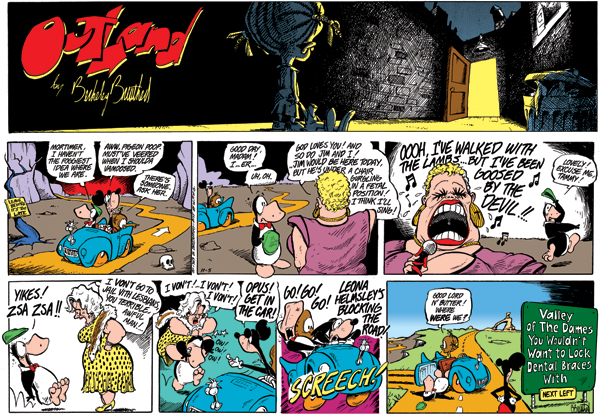 |
For example, Universal Press Syndicate, which distributes "Doonesbury", suggested that newspapers "offer two comics pages that each have a row of strips next to other features rather than one comics page with two rows of strips crammed in side by side" ("Syndicates" par. 35). Cartoonist Berke Breathed advocates "running ads on [newspaper] comics pages-which could bring in enough revenue to allow for an additional page or pages" ("Cartoonists" 50). Breathed, creator of "Bloom County" and "Outland," would eventually quit cartooning altogether because of "frustration with the size limitations of newspaper comics, which used to be published much larger ("Comic Retirements" par. 25). |
|
|
|
|
The comics page has drastically changed as a result. Strips of the past like "Pogo," "Judge Parker," and "Dick Tracy" have nearly vanished, replaced by modern Dilbert's & FoxTrot's. Pogo, drawn by Walt Kelly, follows the adventures surrounding a multitude of animals in a southern swamp depicted in meticulous detail. Kelly's strip was fast-paced and animated, each panel filled to capacity. Recent comic strips offer nothing for comparison. Two-thirds of the average daily "Dilbert" comic strip is white space. Robert C. Harvey, author of several books on the aesthetic history of comics and a regular contributor to The Comics Journal adds, "the simple drawing style could be used to justify the diminutive dimension of strips drawn in that fashion: editors looking at the minimalist artwork could find it easy to deny such strips any more than the barest minimum of display space" ("The Simple Truth" II 2). According to editors, comic strips didn't deserve more space, yet the reduction of space had caused the comics to become artistically banal. "Calvin and Hobbes" creator Bill Watterson claims that he worked with a third less space for his strip than what was given to Walt Kelly twenty years before (97). Another cartoonist who retired because of space limitations, Watterson adds, "at current sizes, there is no room for real dialogue, no room to show action, no room to show exotic worlds or foreign lands, no room to tell a decent story ... Comics are simpler and dumber than ever" (97).
|
| While Bill Watterson may overly dramatize the state of cartooning, the origin of the comics - what brings readers back week after week, day after day - is mistreating the medium. Newspapers will not begin to respect the comics until the public starts acknowledging them for their true significance. One look at Winsor McCay's "Little Nemo in Slumberland" will demonstrate the visual potentiality of the comic strip: a small boy's dreams magically come to life, filling a whole newspaper page with McCay's remarkable rendering skill. One look at Walt Kelly's "Pogo" will prove what has been lost and can be recaptured only if comics are given more space. Imaging the brilliance of Lynn Johnston's "For Better or For Worse" if newspapers allotted more space for her work. How small will the comics get? Why must a weather map take a whole page in the newspaper while the comics, the most unique graphic elements of a newspaper, suffer? Must the comics lose all the visual and artistic components that they are capable of? Once comic strips are recognized for their contributions to society and are appreciated as a historically artistic medium, the comics will receive the attention they deserve. |
Works Cited:
Rublowsky, John. Pop . New York: Basit, Books, 1965.
Owen, Howard. "Re.: Shrinking Comics." E-mail to the author.
2 Oct. 2002
"Comic retirements: a fluke or a trend?" Editor and Publisher
(Dec. 9, 1995).
"Syndicates are on a web-width watch." Editor and Publisher
(Feb. 10, 1996).
Groensteen, Thierry. "Why are Comics Still in Search of Cultural
Legitimization?" Trans.
Watterson, Bill. "The Cheapening of the Comics." The Comics
Journal Sep. 1990: 93-98.
Astor, David. "Cartoonists discuss shrinking comics." Editor
and Publisher 13 Oct. 1984: 50- 52.
Harvey, Robert C. "The Simple Truth: They Hate the Comics."
The Comics Journal Nov. 1999: 11-113.
Inge, M. Thomas. Comics as Culture. By M. Thomas Inge. Jackson:'University
Press of Mississippi, 1990. xi-xxi.
Blackbeard, Bill & Martin Williams. Intro. The Smithsonian Collection
of Newspaper Comics. Washington, D.C.: Smithsonian Institution Press, 1977.
11-18.
OneFile. WoTrac. A23963427. Cabell Lib., Richmond, VA. 19 Sep. 2002
http://web2.infotrae.galegroup.com/itw/infomark/0/1/1/purl=rc6-lTOF?swLaep=viva-vcu.
OneFile. InfoTrac. A26163857. Cabell Library, Richmond, VA. 19 Sep.
2002 http:llweb2.infotrae.galegroup.comlitwlinfomarklOlIll1purl=rc6-lToF?sm@_aep=viva-VCU
Smolderen, Shirley. Comics and Culture: Analytical and Theoretical
Approaches to Comics. Eds. Anne Magnussen and Hans-Christian Christiansen.
Copenhagen: Museum Tusculanum Press, 2000.
Home - Student Projects - Next
